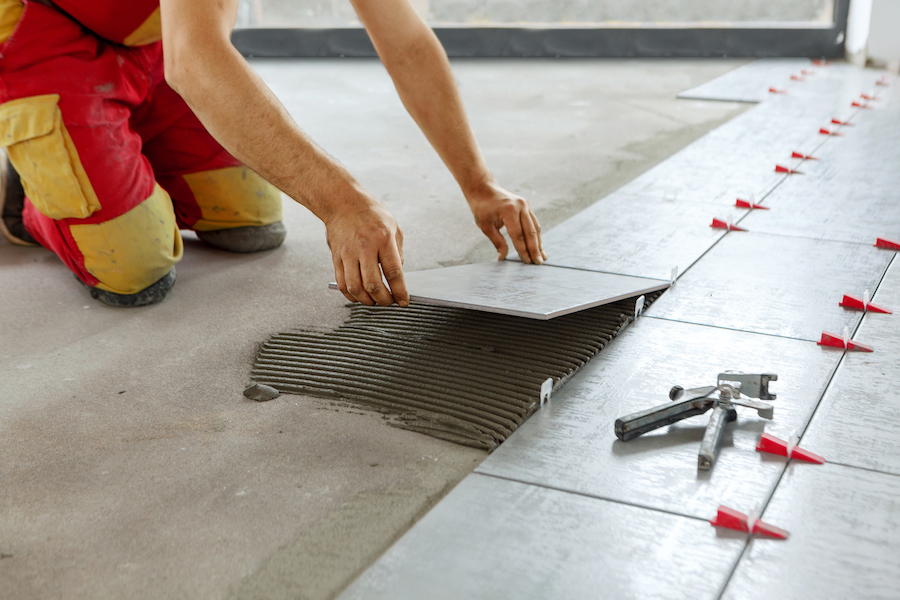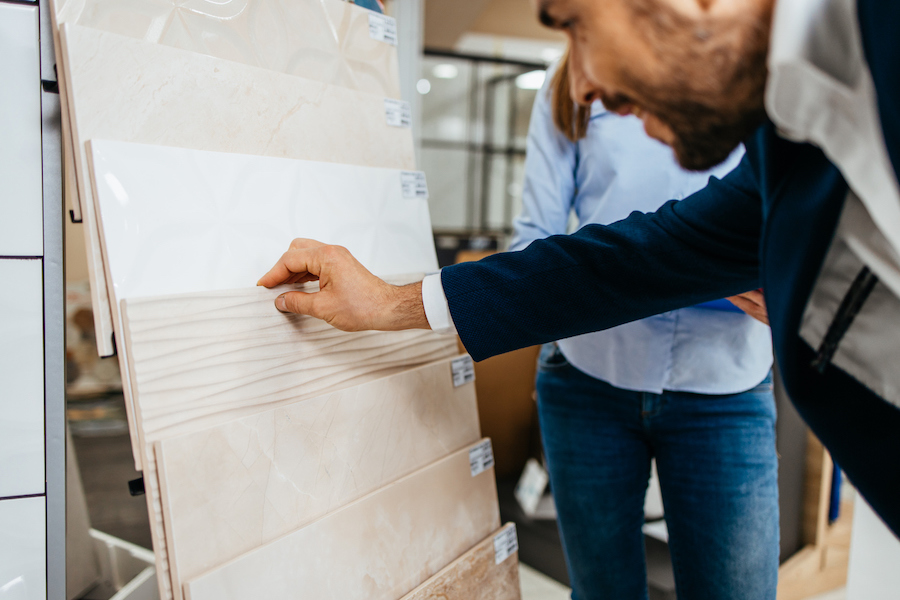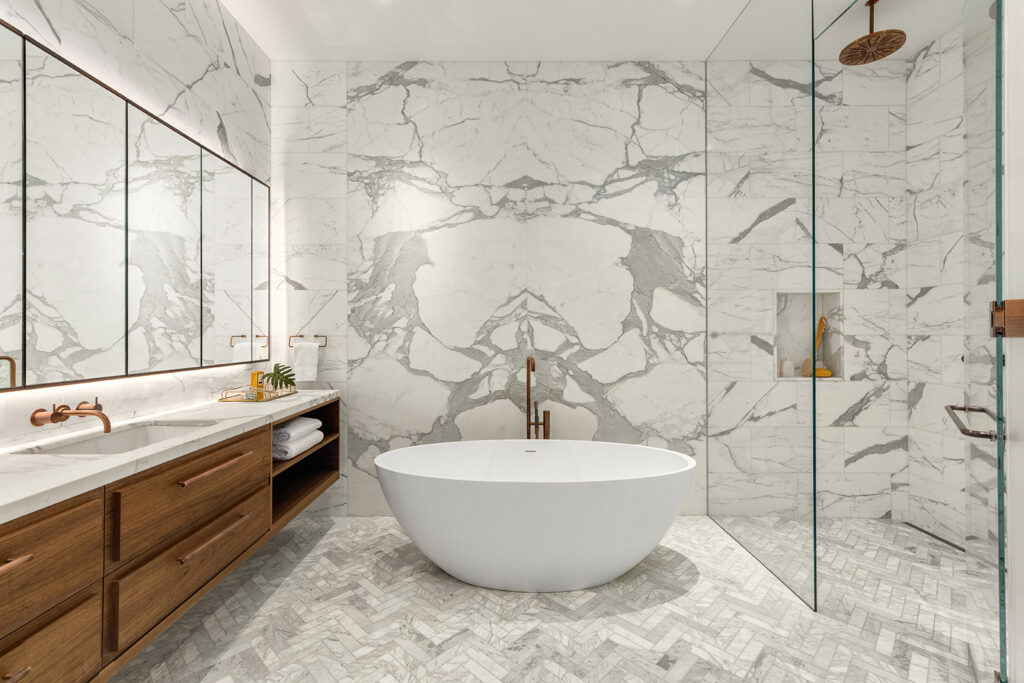
One-Piece vs Two Piece Toilet – Pros and Cons- 2025 Expert Guide
When upgrading your bathroom, one of the most important—and often overlooked—decisions is choosing between a one-piece or two-piece toilet. While
Tiling your bathroom can be an expensive project. However, adding tile can bring many benefits to the look and feel of your home. If you are looking to retile your bathroom floor, then here are a few things to consider in 2024.

Many factors go into tile cost, usually the tile size, hardness, and your installer’s ability. Essentially, you will be paying for the material of the tile and the labor required for cutting and installing the tile in your space. The easier it is, the cheaper the cost, and the more difficult the project, the more expensive it will be.
The overall design and pattern you want will impact your final price. If your design involves multiple tile sizes or any custom shapes or patterns, expect it to be reflected in your final price.
The larger the tile, the quicker the installation time will take. Conversely, the smaller the tile, the longer the job will take, resulting in higher costs.
Tile hardness will dictate how much someone will charge you for cutting the tile. Expensive material such as stone or porcelain is difficult to cut, so their prices reflect that. On the other end, ceramic and slate are easier to cut, which lowers their overall price.
The most qualified and experienced tile installers garner business from word of mouth, and they aren’t starved for business. This means that they will demand a higher price for their work.
Depending on your bathroom size, you will be charged based on your overall floor size. Tiles are generally constructed based on pre-existing size specifications. If your bathroom requires custom-cut tiles, expect to be charged extra for the labor required.
To begin tiling, your existing floor must be removed. This price will range anywhere from $1.00 per square foot for easy-to-remove flooring to $2.00 per square foot for difficult flooring.
Your location will dictate how much tiling will ultimately cost. Cities will demand a higher labor rate than rural areas.

When it comes to choosing your tile material, there are a few options to choose from:
Ceramic tile is made up of sand, natural products, and clay that is molded into an appropriate shape and then fired in a kiln to harden. The result is a material that is fairly water-resistant and inexpensive. You can expect to pay $.50-7 per square foot of ceramic tile.
Marble tile is made from metamorphic rock that is cut into tiles. It is a popular choice and retains a classic look that’s quite durable. Marble tile costs anywhere from $10-20 per square foot.
Travertine is a form of limestone that is cut into tile shapes. The material is very durable and tough but extremely expensive. You can expect to pay anywhere from $15-30 per square foot for travertine or any natural stone tile.
Slate tile is made by cutting tile from slate rock, creating a highly durable material. Slate is heavy, increasing its install cost. You can expect to pay anywhere from $5-20 per square foot of slate tile.
Vinyl tiles are made from polyvinyl chloride plastic or PVC, which is then heated and then pressed into thin layers to adhere to vinyl sheets. These sheets are cut into tiles, resulting in a tile material that is inexpensive and can emulate the look of more expensive materials like wood and stone. Vinyl tile costs anywhere between $1-5 per square foot.
Porcelain tiles are made by heating clay at high temperatures. The result is a more durable material resistant to moisture and staining than ceramic. Porcelain tiles cost anywhere from $2-10 per square foot.
With tile installation, there are a few additional costs to consider, mainly the supporting structure of your floor. Any damage to your home’s structure can be disastrous for your floor if not remedied immediately.
Before flooring can be placed, an underlayment or base layer will need to be placed. The choices are as follows: Uncoupling Membrane, Cement board underlayment, or Self-leveling underlayment. Each of these underlayments has its own positives and negatives, but they will also cost anywhere from $3.00 to $ 5.00 per square foot to install.
Roof damage can lead to extensive water damage in your bathroom, specifically around your toilet and shower. When your flooring is replaced, you will need to repair any damaged or moldy areas. Sheathing replacements can cost anywhere from $5.00-7.50 per square foot to replace but is necessary to ensure the longevity of your bathroom.
In general, hiring professional cuts out all of the guesswork with remodeling. The professional understands their field and will complete your job within a specified time, allowing you to continue your business until it is completed. However, professionals are much more expensive and have their schedules, meaning that a job can either take one week or be dragged out for a month if you are unlucky.
Conversely, retiling your floor yourself is more straightforward as you can approach the job at your leisure, and in the long run, it will be much cheaper than hiring a professional. On average, retiling your bathroom floor will cost anywhere from $400-4,000 depending on the size of your bathroom and the material you have chosen. If you hire a professional, you can expect to pay an additional $2,000 for labor costs.

Before you begin your remodeling project, consider these questions carefully:
Depending on the location of your tile, this will drastically alter the price of your installation. Counter, wall, or flooring will require different tile styles and affect your final costs.
Depending on the square footage of your space, size, and your overall design will impact your costs. Generally, the smaller the size, the more expensive your installation costs will be. This is because the tile size needs to be cut to fit the specific space.
What purpose does your tile floor serve? Are you trying to create a unique pattern, or do you want comfortable flooring? This will help you better select the tile floor that’s appropriate to your home.
What kind of bathroom are you trying to tile? If it’s a master bathroom, then your budget can be expanded. But, if it’s a bathroom that seldom sees use, consider more cost-effective materials such as vinyl.
The type of tile you select will determine your initial price point. If you like dense material such as limestone or marble, your bathroom floor will already have a high initial cost.
Does your home have any unique challenges, such as height challenges or floor weaknesses? These can impact the final cost of your project and add to your labor costs.

Eric is the founder and president of Badeloft USA. He has been the president of Badeloft’s US division for over ten years and oversees all marketing and branding aspects of Badeloftusa.com.
His expertise lies in small business development, sales, and home and bathroom industry trends and information.
Contact us with any business related inquiries.

Free material samples and tub templates

When upgrading your bathroom, one of the most important—and often overlooked—decisions is choosing between a one-piece or two-piece toilet. While

Small details, including what you place on the floor, can make a big difference when setting up or upgrading your

Plumbing traps may seem like small components, but they are critical in keeping your home safe and odor-free. Two of
When shopping for new bath linens, the difference between a bath towel and a bath sheet can feel subtle, but
Fill out the form below to request a free material sample
"*" indicates required fields
"*" indicates required fields
"*" indicates required fields